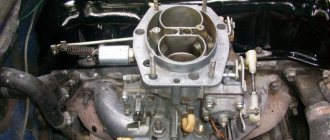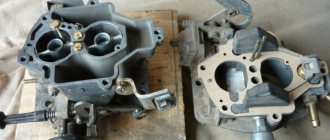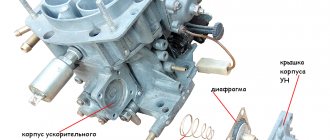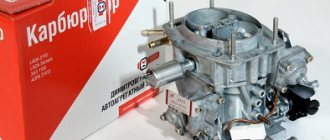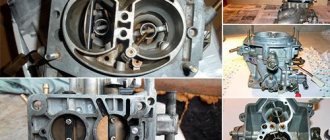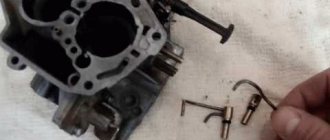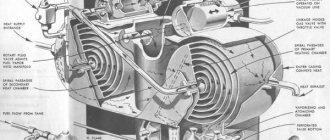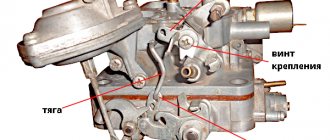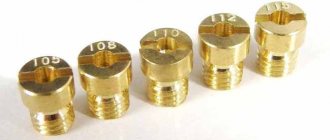A carburetor is an important element of a car's fuel system. Its main task is to prepare the air-fuel mixture and seamlessly transfer it to the engine combustion chamber. Solex 21073 is one of the best designs of an emulsion two-chamber carburetor. It consists of two main elements: a massive lower part and a lighter lid. Taking into account the increasing requirements for environmental safety and decisions of the European Union Commission, all manufactured cars must comply with Euro 2 and Euro 3 standards. The Solex carburetor allows you to fulfill these rules.
Device and principle of operation
The basic principles of mixing fuel and air using a simplified scheme are demonstrated in the figure.
As the piston moves downward from top dead center, the intake valve opens, allowing the air-fuel mixture to be drawn in from the carburetor. At this moment, in the diffuser 6 of the mixing chamber 8, the fuel coming from the atomizer 4 through the nozzle 9, metering the fuel flow, is mixed with the air sucked in through the air damper 5. The flow of the air-fuel mixture is regulated by the throttle valve 7, connected to the gas pedal.
One of the main parts of the carburetor design is the float chamber 11. The operation of the engine depends on its correct setting. The fuel level in the float chamber is regulated by the position of floats 10 - there are two of them in Solex. When gasoline enters chamber 11 from fuel line 1, the floats float up and block the flow of fuel through needle valve 2. In this case, the air displaced from the float chamber leaves through technological hole 3.
Sprayer 4 is designed in such a way that its upper cut edge is slightly higher than the fuel level in the float chamber. As the air flow passes through the diffuser, gasoline is sucked in and further mixed with air. If there is too much fuel in the float chamber, it may leak out. If the mixture contains too much gasoline, it will lead to the following negative consequences:
- pouring candles;
- incomplete combustion of fuel;
- increased fuel consumption;
- reduction of engine thrust;
- increase in the volume of harmful emissions.
When the level of gasoline in the float chamber is low, it is difficult to suck it in. The air-fuel mixture contains an insufficient amount of gasoline, which leads to unstable engine operation and jerking when driving the car. For this reason, it is necessary to monitor the fuel level in the float chamber and the condition of the needle valve.
Basic faults of Solex 21083
There are malfunctions that are most typical for Solex carburetors:
- clogging of the fuel jet of the GDS;
- the entry of debris into the idle system; the XX jet in the solenoid valve is especially often clogged;
- deformation of the lower surface of the main body due to overheating;
- failure of the accelerator pump diaphragm;
- solenoid valve defect;
- loose fit of diffusers in the housing.
If the body is deformed, air is sucked between the carburetor and the intake manifold, and the engine begins to operate intermittently, as the air-fuel mixture becomes leaner. The idle speed is difficult to adjust, and to correct the defect it is necessary to grind the surface on an emery wheel. If the surface warping is significant, grinding will no longer help; the housing must be replaced.
Over time, the accelerator pump diaphragm can crack, lose elasticity, and ruptures appear in it.
Checking the condition of the diaphragm is quite simple; it does not require removing the carburetor. To get to the diaphragm, you need to unscrew the 4 screws of the accelerator pump cover and remove the part. The condition of the diaphragm is checked by external inspection.
The majority of VAZ cars of the Samara family, and in particular the VAZ-2109, came off the assembly line with a carburetor power system, and only later a small series received injectors. The carburetor system has a simple design and is quite reliable, but its main component, the carburetor, requires periodic adjustment. The VAZ-2109 and other models of the family were equipped with Solex carburetors, characterized by a relatively simple adjustment technology that every car enthusiast can perform.
There are two main carburetor settings - the fuel level in the float chambers and the engine speed at idle (idle). These adjustments are carried out when the engine is unstable at idle and when certain symptoms of improper operation of the power system appear:
These problems indicate that the fuel level in the chamber is not normal.
Installing a carburetor on a Niva
Until 1994, the Niva 2121 was equipped with Ozone carburetors, which still operate successfully to this day. Assessing all the positive and negative aspects of existing designs, AvtoVAZ began installing Solex 21073 carburetors on the Niva. According to numerous car enthusiasts, this mechanism is more economical than Ozone. The engine is characterized by better performance, but it becomes more difficult to configure, more capricious to the quality of gasoline and oil vapors penetrating from the crankcase.
You can install or replace the carburetor yourself using standard tools. First, you need to dismantle the air filter, loosen the fuel line clamp and carefully remove it from the fitting, draining the gasoline in the fuel line into a prepared container. Then you should loosen the clamps and remove all pipes connecting to the carburetor:
- draining fuel into the fuel tank;
- carburetor heating unit;
- vacuum regulator of the ignition distributor;
- exhaust gas recirculation systems;
- suction of crankcase gases.
By removing all the electrical connectors, you can remove the throttle linkages and the choke control cable. Having disconnected all external communications from the carburetor, it is necessary to unscrew the nuts securing it to the intake manifold. Then you can carefully dismantle the mechanism. Installing a new carburetor is performed in the reverse order.
Restoring functionality
To troubleshoot a Solex carburetor, in most cases it is necessary to remove it from the engine. The operation is performed in the following order:
- the air filter housing is dismantled;
- the supply and return fuel lines, air tubes, wires, air and throttle valve control cables are uncoupled;
- The nuts securing the device are unscrewed.
When disassembling the device, all work should be done on a table or workbench covered with cloth or paper. The parts should be laid out in a certain order, which will allow nothing to be lost or mixed up during installation. Adjustment of the needle valve to set the optimal fuel level in the float chamber is carried out using a special template. The carburetor on the VAZ engine is installed in the reverse order, after which, if necessary, it is adjusted.
Instructions for adjusting the carburetor
Solex is a fairly reliable device, but it is advisable to carry out the necessary adjustments every six months of vehicle operation in order to optimize engine performance and save gasoline. These include: adjusting the quality of the fuel mixture, its level in the float chamber and the number of idle speeds.
Before carrying out any calibration work or troubleshooting, it is advisable to clean the carburetor of dust, oil and other contaminants. It is more convenient to do this with the air filter removed.
When adjusting the Solex carburetor installed on the Niva, you need to put the gearshift knob in the neutral position, start the engine and let it run for about five minutes. This will allow the fuel pump to fill the chamber. Then you should remove the fuel hose from the carburetor, after turning off the ignition. To prevent the gasoline remaining in the fuel line from leaking onto the engine, prepare in advance a container into which it can be drained. After this, dismantle the choke control cable and remove the screws securing the carburetor cover to its body. When removing the cover, you need to be extremely careful not to damage the gasket and fastenings of the floats.
Having gained access to the float chamber, it is necessary to measure the fuel level. It is convenient to do this with a caliper with a depth gauge. The distance from the edge of the chamber to the edge of the fuel should be 24-25 millimeters. If these values do not correspond, you should bend the tongue on the float axis in the desired direction, put the cap in place, start the engine, and then repeat the procedure of removing the cap and measuring the fuel level.
The idle speed setting is carried out on a warm engine. First, use a flat-head screwdriver to tighten the mixture quality screw located on the base of the carburetor until it stops. It has a left-hand thread, so it should be screwed counterclockwise. Then you need to unscrew it five turns and start the engine. Having removed the choke (air damper), we make minimum but stable engine speeds by rotating the fuel supply amount screw. Then, slowly turning the quality screw, you need to achieve unstable operation of the motor, and after that, unscrew the quality screw one and a half turns. This is enough to restore stable operation. You can set the recommended rpm (850-900) using the quantity screw.
How to set up a Solex carburetor
The best carburetor is SOLEKS. Therefore, many drivers replace their standard carburetors with devices of this type. Solex works clearly even if there was a strong overflow of fuel.
As it turns out, many people have difficulty setting up the SOLEKS carburetor correctly. It must be configured so that fuel consumption is minimal and power is maximum, so you need to look for the “golden mean”. Therefore, those who do not want to learn the subtleties and nuances of setting up give this job to a professional.
But, for those who want to learn how to adjust and configure a Solex carburetor, we will describe the correct procedure:
- It is necessary to set the level in the float chambers. The manual (instructions) states that the level can be set using a special template. This is difficult if there is no factory setting. If there is no factory setting, you need to do it yourself. How to do it? To do this, start the internal combustion engine and warm it up for about 10 minutes. Next, turn off the engine and disconnect the fuel supply hose. When the hose is disconnected, gasoline flows out normally, but fuel must not be poured into the chamber, otherwise the readings will be spoiled. Next, unscrew the carburetor cover bolts and remove the choke cable. After disconnecting the cable, you must very carefully and horizontally remove the Solex carburetor cover. If you do this carelessly, the floats may be damaged. Now you need to measure the distance from the Solex cap to the surface of the gasoline. It is necessary to measure in each chamber; the fuel level in them may be different. To determine whether the level is normal or not, you need to add the two resulting distances and divide by 2, that is (distance of camera 1 + distance of camera 2)/2. If the measured distance is between 25 and 35 mm, then everything is normal. If the level goes beyond the limits up or down, then you need to adjust the level. To do this, bend the float in the desired direction and drain some of the fuel.
- We adjust the idle speed of the internal combustion engine. It often happens that when you press the clutch pedal, the engine speed immediately drops - this indicates that the idle speed has disappeared. To do this, warm up the car engine to normal operating temperature. Next, turn off the engine. In the hole in the Solex sole we look for the mixture quality screw and turn it to the right until it stops. Now you need to start the internal combustion engine and push in (remove) the choke. This screw is used to set the permissible minimum speed. This number of revolutions should ensure stable, stable operation of the motor, while the vacuum should be minimal. A well-tuned Solex carburetor should allow the engine to idle at speeds from 500 to 1200 rpm. After the engine begins to operate stably, we continue to rotate the mixture quality screw until the internal combustion engine begins to operate unstably, after which we turn it back 1-2 turns. Next, we proceed to setting the engine speed to normal; we need to make sure that the speed is in the range from 800 to 900 rpm. Turn the screw until the engine starts running stably.
- When adjusting the idle speed, beginners often have difficulties. It happens when you turn the quality screw, the engine operation does not change, but the quality of the internal combustion engine must change. When the engine is unstable, the mixture quality screw can be adjusted. If the engine does not respond to changes in the adjustment of this screw, then fuel continues to flow into the idle channel, the screw cannot close it. This may be due to an enlarged nozzle (hole for metered fuel supply) or due to a poorly screwed plug, as well as a deformed nozzle. This can be done by carrying out a simple diagnostic procedure: with the engine running, you need to unscrew the valve - here the engine should stall. If the problem is in the enlarged nozzle, then the internal combustion engine will suddenly turn off, and if the internal combustion engine does not stall at all, then gasoline is not supplied through the nozzle. In this case, when the engine does not stall with the carburetor valve removed, then we check the stopper screw of the second chamber. The locking screw is used to smoothly open the throttle valve.
Basic Solex malfunctions and methods for eliminating them
Before looking for problems with the device, you need to make sure that the ignition system is working flawlessly and is adjusted correctly. You also need to check whether the timing belt is functioning correctly, since malfunctions in the operation of this mechanism can also cause malfunctions in the carburetor.
Table 1. Classification of possible carburetor malfunctions and methods for eliminating them.
| Malfunctions | Causes |
Elimination methods
Advantages and disadvantages of tuning
The Solex carburetor is assembled from standard parts and assemblies from various manufacturers and is not subject to individual adjustment. But the cast body, made of aluminum alloy, diffusers, damper jets, as well as fasteners have unprocessed burrs, protrusions, and roughness. The task of tuning is to remove all obstacles to the movement of the air-fuel mixture by grinding, polishing channels and parts with which the fuel flow comes into contact, as well as modifying diffusers and adjusting jets in accordance with the individual requirements of the car enthusiast.
Solex carburetor: modifications
The basic design of these devices was developed by engineers from the French company Soleks.
The Dimitrovgrad plant later received a production license, and all other modifications were made by specialists here. The popular Solex 21073 was developed at DAAZ. Reviews about it are only positive. The mechanism is easy to customize and is highly reliable. DAAZ-2108 is designed to work with a 1.3-liter engine for VAZ 2108 and 2109. Solex 21083 was modified for 1.5-liter power units. The same mechanisms were equipped with models from the first batches of the VAZ 2110 with a microprocessor-based ignition system. On classic VAZ models, Solex 21053-1107010 was installed. VAZ Niva models were equipped with the Solex mechanism 21073-1107010. Now it has been replaced by an injector.
Device
The Solex 21073 carburetor is an emulsion type. Its modifications were initially installed on motors with contactless ignition. The device is distinguished by the presence of two chambers equipped with throttle valves, as well as dosing systems. The device also has transition systems for the first and second cameras. There is an idle system, but only for the first chamber.
The mechanism consists of two halves. The lower one is more massive - and the upper one. This half is the body of the device itself, and the upper part is the cover for the carburetor. At the bottom of each chamber there are rotary-type dampers with a mechanical drive. At the top of the first chamber of the carburetor there is a damper for air supply. It is necessary to start a still unheated power unit. This part is activated by a cable that goes into the cabin and is connected to a lever responsible for the suction and to the starting vacuum system.
Scheme and principle of operation
The types and modifications of carburetors for a given car can be very different, but the principle of operation remains the same.
When starting the engine cold, the driver closes the choke to limit the flow of air and increase the amount of gasoline. This makes it easier to start and brings the speed necessary for stable operation.
Carburetor 21073 DaAZ device and principle of operation: diagram of the design and operation of the carburetor I - first chamber; II - second chamber; 1 — accelerator pump drive lever; 2 — adjusting screw of the starting device: 3 — diaphragm of the starting device; 4 — air channel of the starting device; 5 - solenoid shut-off valve; 6 — idle fuel jet; 7 — main air jet of the first chamber; 8 — idle air jet; 9 — air damper; 10 — sprayer of the main dosing system of the first chamber; 11 — accelerator pump nozzle; 12 — nozzle of the main dosing system of the second chamber: 13 — econostat nozzle: 14 — main air jet of the second chamber; 15 — air jet of the transition system of the second chamber; 16 — channel for balancing the float chamber; 17 - float chamber; 18 — needle valve; 19 — calibrated hole for fuel bypass into the tank; 20 — carburetor fuel filter; 21 — fuel supply fitting; 22 — power mode economizer diaphragm; 23 - fuel jet of the power mode economizer; 24 — ball valve of the power mode economizer; 25 — float; 26 — econostat fuel jet with tube; 27 — fuel nozzle of the transition system of the second chamber with a tube; 28 — emulsion tube of the second chamber: 29 — main fuel jet of the second chamber; 30 - outlet of the transition system of the second chamber; 31, 33 — throttle valves: 32 — slit of the transition system of the first chamber; 34 — outlet of the idle system; 35 — carburetor heating block; 30 - adjusting screw for the composition of the idle mixture; 37 — engine crankcase ventilation fitting; 38 - fitting for supplying vacuum to the vacuum ignition regulator; 39 — vacuum selection fittings for the recirculation system; 40 — main fuel jet of the first chamber; 41 — emulsion tube of the first chamber; 42 - ball valve of the accelerator pump; 43 — accelerator pump diaphragm.
Read also: Rating of infant carriers from 0 to 13 kg
During the warm-up process, air intake is increased to reduce speed and eliminate interruptions. Thus, the air damper opens completely and the amount of gasoline is reduced. Other methods of warming up are not provided for by the design.
Gasoline is supplied through the fuel filter to the float chamber, and then to the main metering system of the mixing chamber. The scheme for pumping air and mixing it with gasoline in the diffuser occurs due to the vacuum that occurs during the operation of the valve mechanism and pistons, compressing and pushing out the working mixture.
The second chamber system is designed to increase air flow to the nozzle when the engine is running under heavy load, when the speed is high.
To ensure that the engine runs stably at idle, and at low speeds to prevent it from stalling and eliminate interruptions, an idle system is provided. And to maintain the level of fuel used in the Solex 21073 carburetor, there is a whole scheme for the operation of the float system. Let's consider the operation of each system separately.
Operating principle
Solex 21073 works as follows. Gasoline will enter the float chamber using the inlet fitting - the fuel also passes through the filter mesh, where it is cleaned, and goes through the needle valve. The chamber with the float is two-sectional, and the sections are connected to each other. They will contain the same amount of gasoline. This design makes it possible to significantly reduce the effect of body tilt on the fuel level in this chamber.
This ensures more stable engine operation. As the chamber fills, the float, pressing part of the needle valve, blocks the access of fuel to the chamber. This maintains a constant level of gasoline in the mechanism. Next, from the float chamber, gasoline flows through the jets into the mixing wells. Air enters these same wells through special holes in the emulsion tubes or air jets. Next, gasoline and air are mixed in them. As a result, a fuel mixture is formed. It will get into the small as well as large diffusers of the device. This is the main dosing chamber. Depending on the operating mode of the engine, certain mechanisms and systems can be started in the carburetor. When the owner tries to start the engine “cold” in order to enrich the fuel mixture, the starting device comes into play. The driver starts it from the passenger compartment - this is a choke.
When the handle is pulled out to its maximum, the air damper of the first chamber is completely closed. At the same time, the throttle valve in the first chamber opens to the distance of the starting gap. It is adjusted using the adjusting screw on the Solex carburetor. Adjusting the gap will allow you to adjust the idle speed.
The design of the Solex carburetor 21073
Carburetor 21073 1107010 DAAZ was developed for Niva cars VAZ-2121 with an engine capacity of 1.6 liters and VAZ-21213 with a 1.7 liter engine. Solex 21073-1107010 is an emulsion, two-chamber carburetor with a falling flow (flow movement from top to bottom). The throttle valves are opened mechanically, sequentially using the gas pedal.
The carburetor has the following components and systems:
- There are two main dosing systems, for the first and second chambers, respectively.
- The float chamber is equipped with a double float and is balanced to prevent tilting, for example when the car is turning, from affecting the operation of the carburetor.
- Crankcase gas suction system.
- A mechanism that blocks the opening of the throttle valve of the second chamber.
- The idle system is connected to the first chamber.
- Idle speed economizer.
- Two transition systems, one for each chamber.
- Power mode economizer.
- Acceleration pump.
- Starting device.
- Heating device.
The location of the main carburetor components is shown in the figures:
The carburetor consists of two halves, the more massive lower one - the body, and the upper one - the carburetor cover. At the bottom of the carburetor, in each of the chambers there are mechanically controlled rotary throttle valves. In the first chamber in the upper part there is an air damper intended for cold starting of the engine. The air damper is controlled by a cable going into the car interior (choke lever) and a vacuum trigger.
Through the inlet fitting, fuel, passing through the carburetor strainer and needle valve, enters the float chamber. The chamber consists of two sections that communicate with each other, so the fuel level in them is the same. The two-section design reduces the effect of vehicle roll on the fuel level and, as a result, on engine performance.
Emulsion tube with air jet
As the float chamber fills, the float, pushing the valve needle up, shuts off the flow of fuel, thus maintaining a constant fuel level in the carburetor. From the float chamber, fuel is supplied through the main fuel jets to the emulsion wells, and air enters there through holes in the upper part of the emulsion tubes (air jets). In the wells, when fuel and air are mixed, an emulsion is formed, which enters the small and large diffusers of the carburetor. This is the main metering system of the carburetor.
At different engine modes, certain carburetor systems are activated.
Operation of the Solex 21073 carburetor
When starting a cold engine, to enrich the mixture, a starting device comes into operation, controlled from inside the car by a choke handle. In the maximum extended position, the choke handle turns the lever through the drive cable, completely closing the air damper (first chamber). In this case, the throttle valve of the first chamber opens slightly to the size of the starting gap, which can be adjusted with the adjusting screw for slightly opening the throttle valve of the first chamber on the lever.
The starting device consists of a cavity connected by a channel to the space of the intake manifold, a diaphragm and a rod connected to the air damper. After starting the engine, the vacuum in the intake manifold acts on the diaphragm and the rod opens the air damper to the amount of the starting gap (regulated by the starting device screw). When the handle is returned to its normal, recessed position, the starting gaps decrease. The gaps in intermediate positions are completely dependent on the geometry of the lever and do not require adjustment. The throttle valve of the second chamber is blocked through a system of levers, when the choke is extended, so when you press the gas, the second chamber does not participate in the operation to avoid engine failures.
The idle speed system (IAC) is designed to power the engine at minimum speed, preventing it from stalling when there is no load. Fuel enters the CXX through the main fuel jet of the first chamber, then the idle jet, mixed with air entering through the idle air jet, as well as from the wide part of the diffuser of the first chamber. Such an air supply system to the CHS ensures a stable transition to this mode. The resulting emulsion enters the first chamber through an opening located under the throttle valve. The channel leading to the idle speed outlet closes the quality screw. The engine speed is regulated by the so-called quality screw, which determines the amount of throttle clearance in chamber number one in idle mode.
When you smoothly press the gas pedal, the transition system of the first chamber is activated. Its throttle valve partially opens, and additional fuel begins to flow from the gap in the transition system, which is located above the valve, enriching the mixture. The transition system of the first chamber does not allow failure when transitioning from idle mode when starting the car.
The transition system of the second chamber is designed in a similar way, with the only difference being that it enriches the mixture during the transition from medium to heavy loads, and its outlet is round. This system helps to avoid dips when the vehicle is moving.
When the dampers are opened sufficiently strongly, the power mode economizer comes into operation. The economizer takes fuel directly from the float chamber and is controlled by the vacuum in the intake manifold. When the damper is closed, the vacuum is high, and the economizer diaphragm does not act on the ball valve, which blocks the fuel flow. When the damper opens, the vacuum decreases, the spring acts on the diaphragm, and it acts on the valve ball, opening the way for fuel through the economizer jet into the emulsion well, and, bypassing the main fuel jet, enriches the fuel mixture.
When operating at maximum loads, the engine requires additional fuel. It is supplied by an econostat directly from the float chamber, through a system of channels to the sprayer in the second chamber.
The accelerator pump is another carburetor component. The accelerator pump enriches the fuel mixture when accelerating the vehicle. It consists of a lever, a diaphragm and a spray. The cam mounted on the throttle valve axis, when it opens, acts on the pump lever, which acts on the diaphragm, which pumps fuel through the nozzle into the first chamber of the carburetor. The pump design has two check valves. The first is located in the channel connecting the float chamber and the pump cavity, and opens when the latter is filled under the action of a spring that removes the diaphragm, like a syringe piston. The valve closes when fuel is pumped into the atomizer (when the gas pedal is pressed). The second valve is located in the accelerator pump nozzle. When fuel is pumped, it opens; if fuel stops flowing, it closes the nozzle channel, preventing air from leaking in and preventing fuel from leaking out. The accelerator pump's cam profile determines its performance.
Forced idle speed economizer (EFS)
The idle system was mentioned above. The CXX carburetor 21073 is equipped with an electromagnetic valve, which is part of the forced idle economizer (EFI). This valve closes the channels of the idle speed and transition system of the first chamber, and is designed to stop the fuel supply when the engine is turned off, as well as in forced idling mode (engine braking), to reduce the toxicity of exhaust gases and save fuel. EPHH consists of a limit switch (see the carburetor picture), an electromagnetic valve and a control unit.
When the ignition is turned on before starting the engine, when the throttle valve of the primary chamber of the carburetor is closed, the thrust screw (quantity screw) with the limit switch is closed to the car body. In this case, voltage is supplied to the solenoid valve and it opens the fuel jet of the idle system. When the engine starts and idles, the solenoid valve receives power from the control unit. As the crankshaft rotation speed increases to 2100 rpm (when the gas pedal is pressed, the connection between the limit switch and the vehicle body is broken), the control unit is disconnected from controlling the solenoid valve, but power continues to be supplied to the solenoid valve until the limit switch is restored will not short to ground. When the throttle valves are abruptly closed (forced idle), the limit switch closes to the car body and the power to the solenoid valve is turned off, and the valve needle cuts off the supply of the fuel mixture.
When the crankshaft rotation speed decreases to 1900 rpm, the control unit is turned on again and voltage is applied to the solenoid valve, the fuel nozzle opens and the supply of mixture from the idle system begins.
This carburetor has a similar design to all carburetors in the Solex line of the Dimitrovgrad Automotive Aggregate Plant (abbreviated DAAZ), but it also has some differences. Since it is installed on engines with a large displacement, the characteristics of its systems have been changed. The accelerator pump nozzle is equipped with only one tube going into the first chamber. The strainer is removed after unscrewing the fuel supply fitting. Carburetor 21073-1107010 is equipped with an exhaust gas recirculation control system through fittings pressed into the body, which are connected through channels to the space of the first chamber above and below the throttle valve.
From the table below you can find out what jets are on Solex 21073 1107010.
Calibration data 21073-1107010
Useful video on the topic:
- Question answer
- Malfunctions
- Adjustment
- Directory
- Device
Starting system
This mechanism is a special cavity that connects to the intake manifold. The device also has a diaphragm and a rod that is connected to the air damper. After the engine is started, a vacuum occurs in the intake manifold. It acts on the diaphragm rod, thereby opening the air damper. If the choke handle is returned to its normal position, this will reduce the starting clearances.
The gap parameters depend on the geometric characteristics of the lever and are not adjustable in any way. As for the throttle valve of the second chamber, when the choke is pulled out, it is in a locked state.
Idle system
This unit is necessary in order to supply the combustion chambers with a combustible mixture at the lowest speeds. Thanks to this system, the power unit will not stall when there is no load. Fuel will enter the system through the main jet into the first chamber. Through the XX jet, where it is then mixed with oxygen, the fuel enters the system through the air valve. This mechanism allows you to ensure stable engine operation at idle speed without load.
Next, the combustible mixture will enter the first chamber through a special channel located under the throttle valve. The fuel mechanism leading to the XX exhaust port is closed with a quality screw. This is an adjusting screw that can be used to adjust and change the characteristics of the carburetor. The operation of the engine in idle mode on the Solex 21073 mechanism is also adjusted with this element. Due to it, the gap value of the throttle valve of the first chamber in XX mode is determined.
Setting the level in the float chamber
So, we looked at the Solex device. Adjusting the carburetor will help set the optimal mode when the engine will operate as efficiently as possible and at the same time fuel consumption will not be too high. First you need to start and warm up the engine a little. Then remove the fuel hose and carburetor cover. Then disconnect the suction cable and twist the cover off the device.
It must be removed as smoothly and carefully as possible so as not to damage the float. Then use a ruler or caliper to measure the distance in each chamber. You need to measure from the mating surfaces to the edge of the gasoline. This size should be about 24 mm. If it is larger or smaller, then the parameter is adjusted by bending the float. Then the device is reassembled, the engine is started and it is warmed up.
Idle adjustment
Many car owners, namely beginners, most often buy old cars and do not know how to adjust the carburetor correctly. The result is power loss, high fuel consumption, floating speed and other problems. After the level adjustment is successfully completed, the idle speed is adjusted. Before doing this, it is recommended to turn off the engine. To work, you will need a flat blade screwdriver and time. There is a hole on the base of the mechanism. It contains a screw responsible for the quality of the mixture. It is screwed in until it stops. However, you should not be too zealous.
Then, from the extreme position, the screw is unscrewed five turns. Next, the engine is started without choke. Unscrew the quality screw - carburetor 21073 will regulate the engine speed. Then the element is screwed in again. It is necessary to rotate until the operation of the power unit becomes as stable as possible. Rotate the screw slowly. When the engine becomes quieter, turn it out no more than one turn. As a result, the idle speed will be about 900. But if the engine stalls, they are slightly increased.
Adjusting the idle speed
Do-it-yourself adjustment of the Solex carburetor on a VAZ-2107 requires certain knowledge from the car enthusiast doing the repairs. The manufacturer recommends installing idle speeds in power units with carburetors 2108, 21081, 21083 from Solex, which vary between 750–800 per minute
It is very important to achieve stable functioning of the system in such a period. To do this, you need to rotate the “amount” screw of the fuel solution, while simultaneously setting the crankshaft speed
Setting the required rotation speed often necessitates urgent adjustment of the “quality” screw adjustment. In cars in which such measures are being carried out for the first time, there should be a plastic plug installed at the manufacturer on the above screw; it is advisable to remove it. An awl or metal hook may be useful for this. If you don’t have both tools, you can screw a self-tapping screw into the unnecessary part, and then remove everything.
In order for the adjustment or installation of the Solex 21083 carburetor on the VAZ-2107 to be successful, the manipulation should be carried out in three steps. If this is not enough, the steps can be repeated several more times.
Before solving such an important task, you need to check the correct installation of the ignition timing, as well as the functionality of the high-voltage wires. If everything works stably and does not cause any complaints from the owner, you must:
- Using a slotted screwdriver, turn the screw responsible for the “quality” of the fuel mixture in order to increase the engine crankshaft speed to the maximum limit. It is necessary to turn the unit in different directions until the “correct” position of the screw is determined upon reaching the maximum frequency value. You can adjust by ear or using the tachometer;
- put the screw for the “amount” of fuel “solution” in such a position that the revolutions reach 900 per minute. Scrolling the screw directly affects the opening of the throttle valve of the first chamber, which is why the revolutions begin to “jump” strongly. Otherwise, if the screw is turned counterclockwise, the throttle valve will close and the speed will drop. The main task of the position-regulating screw is to determine its optimal location;
- close the “quality tap”, achieving 800 rpm from the system.
If a motorist does not know how to install a Solex carburetor on a VAZ-2107, after the previous device has become obsolete or a “quality” screw needs to be replaced, one important feature should be taken into account: before adjusting the device, the screw must be tightened clockwise until it stops, and then unscrewed 3 turns and only then proceed with adjustment.
